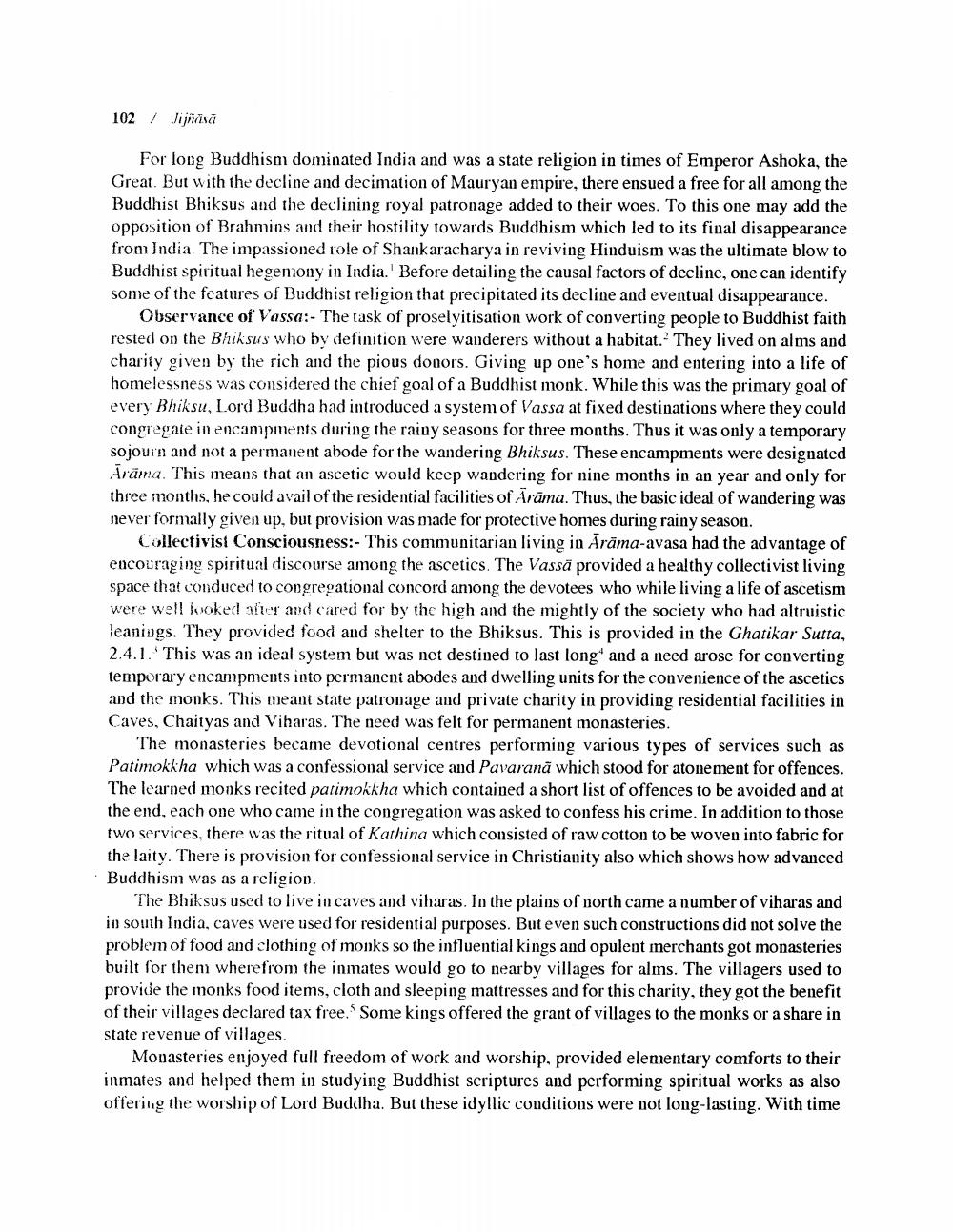________________
102
/
Jijiösa
For long Buddhism dominated India and was a state religion in times of Emperor Ashoka, the Great. But with the decline and decimation of Mauryan empire, there ensued a free for all among the Buddhist Bhiksus and the declining royal patronage added to their woes. To this one may add the opposition of Brahmins and their hostility towards Buddhism which led to its final disappearance from India. The impassioned role of Shankaracharya in reviving Hinduism was the ultimate blow to Buddhisi spiritual hegemony in India. Before detailing the causal factors of decline, one can identify some of the features of Buddhist religion that precipitated its decline and eventual disappearance.
Observance of Vassa:- The task of proselyitisation work of converting people to Buddhist faith rested on the Bhiksus who by definition were wanderers without a habitat. They lived on alms and charity given by the rich and the pious donors. Giving up one's home and entering into a life of homelessness was considered the chief goal of a Buddhist monk. While this was the primary goal of every Bhiksu, Lord Buddha had introduced a system of Vassa at fixed destinations where they could congregate in encampments during the rainy seasons for three months. Thus it was only a temporary sojourn and not a permanent abode for the wandering Bhiksus. These encampments were designated drama. This means that an ascetic would keep wandering for nine months in an year and only for three months, he could avail of the residential facilities of Ārāma. Thus, the basic ideal of wandering was never formally given up, but provision was made for protective homes during rainy season.
Collectivist Consciousness:- This communitarian living in Aräma-avasa had the advantage of encouraging spiritual discourse among the ascetics. The Vassä provided a healthy collectivist living space that conduced to congregational concord among the devotees who while living a life of ascetism were well looked after and cared for by the high and the mightly of the society who had altruistic leaniogs. They provided food and shelter to the Bhiksus. This is provided in the Ghatikar Sutta, 2.4.1. This was an ideal system but was not destined to last long and a need arose for converting temporary encampments into permanent abodes and dwelling units for the convenience of the ascetics and the monks. This meant state patronage and private charity in providing residential facilities in Caves, Chaityas and Viharas. The need was felt for permanent monasteries.
The monasteries became devotional centres performing various types of services such as Patimokkha which was a confessional service and Pavaranā which stood for atonement for offences. The learned monks recited patimokkha which contained a short list of offences to be avoided and at the end, each one who came in the congregation was asked to confess his crime. In addition to those two services, there was the ritual of Kathina which consisted of raw cotton to be woven into fabric for the laity. There is provision for confessional service in Christianity also which shows how advanced Buddhism was as a religion.
The Bhiksus used to live in caves and viharas. In the plains of north came a number of viharas and in south India, caves were used for residential purposes. But even such constructions did not solve the problem of food and clothing of monks so the influential kings and opulent merchants got monasteries built for them where from the inmates would go to nearby villages for alms. The villagers used to provide the monks food items, cloth and sleeping mattresses and for this charity, they got the benefit of their villages declared tax free. Some kings offered the grant of villages to the monks or a share in state revenue of villages.
Monasteries enjoyed full freedom of work and worship, provided elementary comforts to their inmates and helped them in studying Buddhist scriptures and performing spiritual works as also offering the worship of Lord Buddha. But these idyllic conditions were not long-lasting. With time




